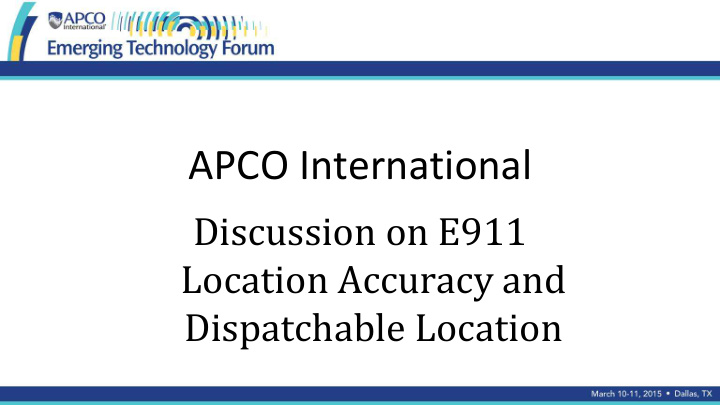



APCO International Discussion on E911 Location Accuracy and Dispatchable Location
Today’s Technology Hybrid A-GPS/AFLT Hybrid combines GPS – Works outdoors and indoors pseudo-ranges with – Outdoor fixes rely predominantly on GPS measurements and cellular pilot highly accurate GPS-only fixes are produced measurements to – Hybrid fixes use both GPS pseudo-ranges and CDMA Pilot maximize accuracy measurements in the same trilateration calculation when an insufficient number of GPS pseudo-ranges are available for a GPS-only fix – Hybrid allows the maximum accuracy when a GPS-only solution is not possible (e.g., two or fewer GPS pseudo-ranges are available) Base Station 3 – Hybrid, perhaps AFLT only in some cases, allows for indoor coverage and nearly 100% yield. – Enhanced Cell ID (E-CID) and Cell ID (CID) provide 100% yield Base Mobile Station Station 1 – Carriers without AFLT today just use GPS E-CID, and CID Base This positioning technology represents the performance baseline Station 2
Today’s Indoor Accuracy From The CSRIC Report – Emulated live 911 Performance on real networks A-GPS / AFLT Newer ranging methods, such as OTDOA and Wi-Fi, will improve E911 indoor performance Dispatchable Location will provide complementary approach to locating the caller Figure 6.1.2-7. Indoor Accuracy by Morphology for Qualcomm
New Technologies Improving Indoor 911 Accuracy • New Access Networks – 4G/LTE – Wi-Fi • New Positioning Methods – 4G/LTE Observed Time Difference Of Arrival (OTDOA) • A highly detectable LTE reference signal designed to outperform 3G solutions – Wi-Fi Positioning • Signal strength and ranging measurements available for E911 positioning • New Network Topologies – Wi-Fi data offloading – Small / Femto cells – Both are a powerful positioning asset for wireless operators • Dispatchable Location – The “Gold Standard” – Use of these new networks / topologies as well as BT beacons
Key Benefits of Wireless WAN (WWAN) • Penetrates buildings – deep indoors • Ranging is possible from cell towers giving a position indoors – 3G/AFLT showed we have indoor coverage – 4G/LTE networks with OTDOA will improve indoor accuracy – 4G/LTE positioning coverage for mobile user base will grow quickly • Leverages existing infrastructure to do positioning • Leverages LTE modem – No new handset hardware required • Leverages trusted, accurate cell tower base station almanac of wireless operators • Multiple bands available for ranging • Strong ecosystem exists
Observed Time Difference of Arrival (OTDOA) • Downlink positioning method (similar to AFLT) – but for 4G/LTE networks • The mobile measures the difference in time of arrival of the new LTE signal between multiple base station pairs • Designed to outperform AFLT (higher bandwidth, increased hearability, inter-frequency, etc.) • OTDOA will be a useful indoor positioning technology eNB eNB Synchronous Deployment eNB
How to Leverage Wi-Fi and BT • Wi-Fi and BT information may be used to supplement cellular indoor positions Specifications exist for: • How to report Wi-Fi MAC address, signal strength and time measurements along with the cellular • and GPS information How to report BT Identifiers • How to send back an alternative (potentially consumer LBS) position to the server, be it from sensor • aided, device specific database solutions, etc. • Challenges – Multiple decentralized databases of unvalidated accuracy exist today – The need for and the issues with creating centralized database(s) • Targeted / Phased Rollouts Possible – Wi-Fi Data Offloading provides the carriers with managed Wi-Fi databases to use for location – Leverage the forming National Emergency Address Database (NEAD) • Wi-Fi and BT solutions can be cross checked – Validate Wi-Fi / BT solution against solution from OTDOA / AFLT / A-GPS methods
WLAN / BT Information in a 911 Call From The CSRIC Report Alternative location estimate / measurements & position source descriptors inserted here • LPPe carries Wi-Fi and BT information • LPPe allows for a position to be returned as well, geographic or civic • LPPe carries uncompensated barometric pressure data • SUPL shown here, but LPPe is equally applicable to a control plane solution
Thank You
Recommend
More recommend